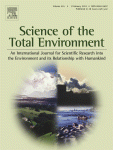Science of The Total Environment 423
Overview of new articles on POPs in a new issue of the Science of The Total Environment journal.

Potential impact of fertilization practices on human dietary intake of dioxins in Belgium
Pages 47-54
P. Dumortier, M. Elskens, J.F. Focant, L. Goeyens, K. Vandermeiren, L. Pussemier
- Dioxins can be transferred from fertilizers to the food chain. We developed a method to assess this transfer for various fertilization scenarios and using published contamination data. General fertilization practices are safe. Some uncommon practices might deserve more attention.
Pages 151-161
Miquel Porta, Tomàs López, Magda Gasull, Maica Rodríguez-Sanz, Mercè Garí, José Pumarega, Carme Borrell, Joan O. Grimalt
- Eight of the 19 POPs analyzed were (each) detected in >80% of the study subjects. The minimum number of POPs detected in one person was 5. There were large interindividual differences in concentrations. POP concentrations decreased 34–56% in Barcelona city in 4years. Our “POP Geoffrey Rose curves” emphasize the population nature of the problem.
Pages 162-167
Nander Van Praet, Adrian Covaci, Johannes Teuchies, Luc De Bruyn, Hans Van Gossum, Robby Stoks, Lieven Bervoets
- We indicated the presence of accumulated POPs in damselfly larvae. The accumulation capacity of damselfly larvae makes them useful for passive biomonitoring. We observed a great variation in POP concentrations among the study ponds. An advance of using damselfly larvae is the accurate reflection of the present bioavailability.
Effect of reactive core mat application on bioavailability of hydrophobic organic compounds
Pages 168-175
Dogus Meric, Sara M. Barbuto, Akram N. Alshawabkeh, James P. Shine, Thomas C. Sheahan
- Reactive Core Mat is a wide spreading remediation technology for contaminated sediments. Efficacy of the RCM on PCB and PAH contaminated sediments experimentally studied. Freshwater oligochaetes (L. variegatus) used to assess the bioavailability. BSAF model biouptake predictions fairly well agreed with the experimental data. RCM seems to successfully isolate the advective flux of contaminants due to consolidation and limited bioavailability.
1.4.2012




